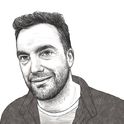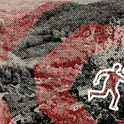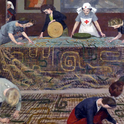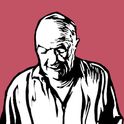Midway through our conversation, Ludovic Slimak plonks a set of teeth on the table. Or, rather, it’s a realistic 3D print-off of a set of teeth. The bottom row of gnashers sits on a stony-looking bit of jawbone. The top row is wired together and bare, with roots pointing upwards like enamel church spires. “These are the most complete Neanderthal remains we’ve found in France since 1979,” says Slimak.
Normally, having such a striking prop between you and your interview subject would be a distraction; and this one was, in a way—my eyes kept flitting involuntarily to the disinterred teeth. But they were always quickly drawn back to Slimak himself, who is an extraordinary character. He is part professorial, with a tweedy waistcoat and an engaging manner of speech, but also part wild-woodsman, with sunbaked skin and a great, unruly beard. His book, The Naked Neanderthal, which was published in France in 2022 and translated into English last year—becoming one of Prospect’s books of 2023—is the work of a historian, an anthropologist, a philosopher, an adventurer, a diarist, a brilliant weirdo.
Slimak doesn’t apply any of those highfalutin descriptions to himself, however. “I use archaeology as a tool to understand Neanderthals, which is an extinct humanity,” he says plainly, when I ask him to explain his work. “And I’ve been interested in this humanity, in this past society, since I was very young.” He recalls childhood jaunts into the French countryside with his father, a forester, who once asked him what he wanted to be when he was older. Four-year-old Slimak, who didn’t yet know about archaeology, replied: “I want to make holes in the soil to find ancient things.”
So that is what Slimak does now. He spends part of his time writing and teaching, but the rest is spent making holes in the soil of the Rhône Valley, where sits a particularly rewarding Neanderthalic site, or visiting other digs, from Ethiopia to the Arctic Circle. Some of the most poetic passages of his book are those that describe just how rare these sites are—there are tens around the world, not hundreds—and how precarious, sometimes exposed and then washed away within hours by water movements. “Each site,” he says, “is a miracle.”
Just what has Slimak found in these places? Pure wonder, it seems. Although he is realistic about the unknowability of the Neanderthals—they disappeared around 40,000 years ago, so they are almost like “aliens” to us Sapiens—he’s also clearly taken with what he does know. “We find ourselves face to face with an infinite creativity beyond compare with the technical products of our societies,” he says. For Slimak, Neanderthals were more sophisticated than us in many ways, even if we—not they—survived in the end.
There are numerous theories for why the Neanderthals died out: climate, disease, interbreeding with other species. Slimak has another. “Neanderthals vanished in a whisper, not in a boom,” he says, “so it’s not an event, it’s a process.” It may even have been a process of eradication. “It’s the hyper-efficiency of Sapiens that has induced the extinction of other humanities and that could induce our own extinction in the centuries to come,” Slimak continues; meaning that, for all the beauty and sensitivity inherent in Neanderthalic societies, Sapiens had the weaponry… and the will.
Slimak is currently going through his own process—of digging his way, stone by stone, to scientific breakthrough. The teeth on the table are part of that effort, which has already shown that Neanderthals and Sapiens came into much closer, much earlier contact in the Rhône Valley than had previously been realised. In fact, analysis of ancient soot has put these two types of humanity within six months of each other—“maximum,” emphasises Slimak.
Just how close was that interaction and what was its nature? That is the question. Slimak’s next book, provisionally called The Last Neanderthal, will try to coax answers from the foggy, unknowable past—and relate them to the present. “Neanderthals enable us to understand us,” he says finally, “as never before.”














